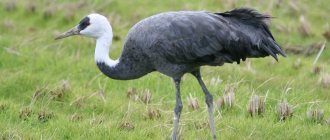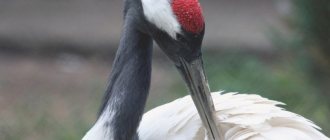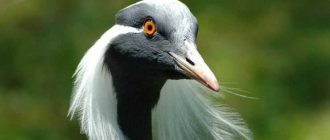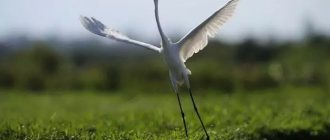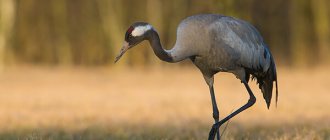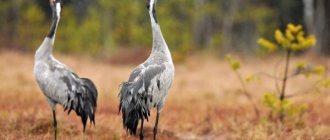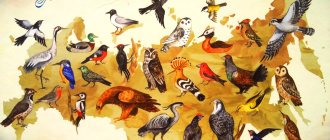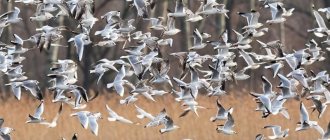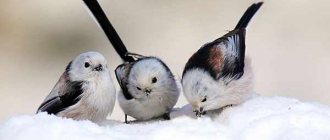The demoiselle crane is often called the little crane. It received this name because of its size. This is the smallest representative of the Crane family. Belongs to Eukaryotes, phylum Chordata, order Crane-like. Forms a separate genus and species.
Of all species of the family, it ranks third in terms of the number of individuals. In total, one can hardly count two hundred representatives in the world. A hundred years ago, birds were actively popularized in the territories of their habitat and there was no threat to them.
Conservation status
Even at the beginning of the 20th century, the belladonna was the most common species in most places within its extensive range. However, over the course of the twentieth century, its numbers declined sharply, and it remained in fairly large quantities only in the dry steppes of the Caspian region, especially in Kalmykia, and in some areas of Western and Central Kazakhstan. The complete population of belladonna is preserved only in Mongolia.
Although the total world population of belladonna is 200,000–240,000 individuals, it is listed in the Red Books of Russia, Ukraine and Kazakhstan. Internationally, the belladonna is classified as a protected species and one of least concern.
Listen to the voice of belladonna
Cranes are known to prefer swampy areas, but belladonnas are not very well adapted to swamps. They occupy mainly savannas and steppes, where there is low vegetation. They can also settle in arable land and nest there. They stay close to rivers, springs, and small lakes.
Grue demoiselle (Grus virgo)
Species and man
Demoiselle cranes, like other species of cranes, have suffered most not from direct destruction (hunting for these cranes, fortunately, is observed only during wintering grounds and on migration in some Asian countries), but from anthropogenic impact. Plowing and intensive use of steppe spaces led to the fact that belladonnas were forced out into dry steppes and semi-deserts, and the number of these cranes sharply decreased. But since belladonnas are quite calm about the presence of humans, since the 1980s. they began to nest on cultivated lands, mainly in Ukraine and Kazakhstan.
In Mongolia, where local nomads and herders treat belladonnas with great love and respect, they are better preserved than in other regions.
Belladonnas are well tamed, and even at the end of the 19th century in Ukraine one could often see these birds walking around peasant yards along with chickens, turkeys and geese.
First impressions
One of the authors of these lines had his first meeting with demoiselle cranes in the semi-deserts of Kalmykia back in 1969, while still a student []. May has just begun: the time of fresh greenery, colorful steppe colors and birdsong. Our expedition vehicle rolled along the dusty roads of the Kumye region. Left behind are the floodplain forests of the middle reaches of the Kuma River and the vast reed floodplains of the lower reaches. Further on, the river was lost among lakes and floods in the steppes and sands of the Caspian lowland.
Our next camp was set up in the evening near Svetly Erik - on the outskirts of a vast lake system in the south of Kalmykia. The trembling ringing of hungry mosquitoes, a fire with fragrant ear, a flickering starry sky and, finally, the midnight silence of the cooling spring steppe... And in the morning we were woken up in the tent by two-syllable duet songs of cranes - a loud, slightly hoarse “krrrrrukrrryy, krrrru-krrryy”.
The first trumpet call of a distant pair of belladonnas sounded just as dawn broke. And soon other birds screamed, keeping in vast hollows among the lumpy sands closer to the camp...
Three years later we returned to these places. As before, pale pink tamarisk blossomed near the water, and cranes trumpeted in the morning in the steppe. The duet call of one of the pairs of belladonnas came first from somewhere behind the distant hills in the east. Then the birds rose into the sky there and, circling against the background of the morning dawn, flew away. In a nearby depression another crane screamed and soon fell silent. And during the day, in this hollow, belladonna grazed among the stunted desert vegetation.
The sharp-sighted crane noticed a man watching him. A short alarm sounded, and immediately a second bird appeared next to the first bird. Together, slowly, they walked to the side, pretending not to notice anything. It became clear that their nest was somewhere nearby!
The story of our famous ornithologist, the wonderful writer and naturalist E. P. Spangenberg (1898–1968) immediately came to mind about his adventures while searching for the first demoiselle crane nest. Having spent more than one field season in the steppes, studying the life of birds for many years, he was finally able to find a clutch of belladonna eggs only after he vowed never to destroy the nests of these cranes again, even for the sake of collecting scientific zoological collections. Surprisingly, taking advantage of Spangenberg’s experience and vowing, if successful, to never disturb these amazing birds again, they managed to discover their nest almost immediately.
Two large greenish-spotted eggs lay right on a bare patch of earth among stunted bushes of wormwood, thyme, cumin, and rare stalks of desert sedge. Around the eggs, the cranes placed in a circle dry grass stems, pellets of sheep droppings, and pieces of thick black rhizomes of some plant that had been collected nearby.
At that time it was believed that birds needed this kind of fence to prevent their eggs from rolling to the sides during strong spring winds. But only much later, and again in Kalmykia, was it possible to find out the real role of this “fence”, which belladonnas used, as it turned out, as a bedding for eggs during the rains, so that the eggs did not get dirty in the clay and did not stick to the wet ground [ ].
Distribution and habitats
The belladonna's habitat covers the arid (dry) zone of Eurasia from the Black Sea region to Mongolia and northeast China. In Russia, belladonna is distributed in the steppes and semi-deserts of the European part, the Urals, Western Siberia, Altai, Tuva, and Transbaikalia.
The nesting biotopes of belladonna are flat or slightly hilly steppes and semi-desert areas on the plains or in the foothills with sparse grass of wormwood and grasses, while the presence of a lake or other body of water is required no further than 1.5 km. In steppe mountain valleys and mountain steppes, belladonnas can rise to a height of 2300–2400 m above sea level. Unlike other crane species, this species avoids swampy areas.
What natural zone does it live in?
Experts say that there are 6 populations of belladonna belladonnas. The habitat includes 47 countries. Often found in Russia, it inhabits the eastern and central territories of Asia, the Republic of Kazakhstan, Mongolia, and Kalmykia. In these areas there are many individuals, tens of thousands.
They are found in smaller numbers (no more than 500) in the Black Sea region. They also lived in small numbers in northern Africa. According to recent research, there are none left on the continent. A small number of individuals have been recorded in Turkey.
In some parts of the world, the demoiselle crane is considered an endangered or critically endangered species. Therefore, it is a protected taxon.
Demoiselle differs from other species in that it does not prefer swamps. Although, if necessary, it can still nest there. But they cannot be compared with grassy open areas. Found in steppe regions. They like to inhabit savannas and semi-deserts, located 3 km above the sea.
They do not disdain arable lands and other agricultural lands, where they can find food and quench their thirst. The love of water also forces one to choose the banks of streams, rivers, lakes and lowlands.
The habitat is significantly influenced by the transformation of localities. Thus, the species is forced to inhabit steppe and semi-desert zones, which leads to an active decline in the population. But it should be noted that due to the displacement, belladonnas included cultivated lands in their range. Which means an increase in population in the territory of Ukraine and the Republic of Kazakhstan.
Appearance
The demoiselle is the smallest of the cranes, its height is about 90 cm, its wing length is about 50 cm, and its body weight is 2–3 kg.
The plumage of the body is bluish-gray, the head and neck are black, and there are long tufts of white feathers behind the eyes. The characteristic bald spot on the head of cranes is absent. The beak is short and dark. The legs are black, and the toes of demoiselle cranes are shorter than those of other cranes, which makes it easier for them to walk and run in rather dense steppe vegetation. The cornea of the eyes is reddish-orange. There is no sexual dimorphism in coloration, although males look somewhat larger than females.
Juveniles are light gray with an almost white head. The tufts of feathers behind the eyes are also gray and only slightly elongated.
Interesting facts about cranes
They can never be seen on tree branches; they love comfort very much. Sitting on thin, bending branches is not for these proud birds. There is an ancient legend that once a pair of cranes, very tired on the road, sat on a dry tree, and at night lightning struck the tree and it caught fire. The birds were fast asleep, and the flame touched their legs, severely scorching them. The creatures took off in horror, but one could not get out of the flames. Since then, none of the birds sit on the tree and you can often hear their plaintive cry. Of course, one can argue about the veracity of the legend, but the fact that they do not sit on trees is a fact. Other equally interesting facts:
- Cranes are very romantic birds. They choose a mate for life. Only in the event of the death of a partner or the absence of offspring can the other half form a new couple.
- These majestic birds are depicted in rock paintings of ancient people.
- The people of Armenia also did not ignore this genus of birds, making them a national symbol of the country, which personifies happiness, love, health, and prosperity. For the Chinese and Japanese, this creature is a symbol of wisdom, honor, beauty, longevity, and vigilance. In Christianity it is often associated with the sun and pine. And in Russia the crane is a symbol of fidelity.
- The bird is the hero of numerous tales, fairy tales, legends, films, and cartoons. For example, in the cartoon "Kung Fu Panda", Master Crane is one of the Furious Five. This character's fighting style is based on precise balance. His wide wings and long beak help him in this.
- One of the satellites of the “Land of the Rising Sun” is called “tsuru”, which means crane. The Japanese firmly believe in the superstition: if a sick person needs to recover, but he cannot do this for a long time, then he needs to create origami from a thousand paper cranes. Then the person will receive good health.
Video
Lifestyle and social organization
Demoiselle cranes are monogamous and remain in pairs for life. Their loyalty to each other became almost legendary, they were even called "people in bird feathers." The modern scientific name for belladonna is Anthropoides, which means “humanoid” in Greek. However, if there are no children in the crane family, i.e. nesting is not successful, the pair breaks up; This happens, however, very rarely.
Pairs are formed during the winter, when belladonnas stay in common flocks. The formation of a couple is accompanied by certain rituals. Firstly, this is a kind of singing, when a couple seems to be talking to each other, emitting a series of melodic sounds. The pose is also very characteristic - the head is thrown back so that the beak is directed vertically upward. Such singing in a duet can last several seconds, or maybe more than a minute. Singing is usually accompanied by “dancing,” when belladonnas jump in front of each other, toss tufts of grass or sticks, and flap their wings. All pairs nesting nearby usually gather for dances. The birds form a large circle, and if there are many of them, they line up in 2-3 rows. In the middle of the circle, several birds “dance”, accompanying the dance with trumpet calls. After some time, these “dancers” leave the ranks of the “spectators” and new “performers” take their place. Compared to other cranes, the dance of demoiselles seems more energetic and flexible.
The voice of belladonnas is a ringing croak, higher and more melodic than, for example, that of the gray crane.
Demoiselles are migratory birds; they spend the winter in northeast Africa and the Hindustan Peninsula (Pakistan and India). Demoiselle belladonnas fly to winter in large flocks of up to 400 individuals. They fly relatively low above the ground and, only crossing the Himalayas, rise to a height of 5000–8000 m. During the flight, the cranes periodically change places and make loud trumpet sounds. It is through this “purring” that people on the ground discover a flock of cranes flying high. Demoiselles fly with their heads and legs stretched out and either slowly and evenly flap their wings or soar smoothly in the air. During wintering, they often stay in common flocks with gray cranes, choosing shallow waters or flat river islands for overnight stays. During the day they fly to feed in harvested fields of wheat, millet and other grain crops.
In spring, demoiselles return to their nesting sites in small groups of only 4–10 birds.
Lifestyle
The belladonna's voice is a high and melodious purr.
Demoiselle cranes prefer flat or slightly hilly areas on the plain or foothills with low grassy vegetation. There are cases when belladonnas nest in fields, mainly in wheat and barley crops.
- 34 facts about lions
- Lynx
- 37 facts about cheetahs
- Scolopendra
- 32 facts about tigers
- Weasel
Birds of this species are monogamous, and, as a rule, pairs formed at wintering sites remain throughout their lives. The “wedding” is celebrated with a joint “song”, which consists of a series of complex drawn-out melodic sounds. In this case, the birds throw back their heads so that their beaks point vertically upward.
The demoiselle crane nests on the ground, in a dry place, usually close to water. The nest is made in a shallow hole (sometimes without one).
Belladonnas feed mainly on plant foods: stems, young shoots, and seeds. But if the opportunity arises, they do not refuse insects, as well as other small invertebrates. The need for animal food especially increases during the period when chicks are growing up in the nest: after all, everyone needs strength to raise the young generation!
The natural enemies of belladonnas are dogs, foxes, and eagles. Male cranes in some cases even join forces to protect their nests. If trouble happens to someone, the bird can call for help with a loud cry - and males from nearby nests rush towards danger. After all, together they can drive away even large predators.
Demoiselles live on average about 30 years, although there is a known case when birds in captivity lived up to 67 years.
Nutrition and feeding behavior
In general, the demoiselle crane is a herbivorous species; animal food is more often used during the nesting period. Among plant foods, cranes usually eat the seeds of cereals and legumes, but they can also eat the vegetative parts of some forage grasses, for example, alfalfa. In the second half of summer, they sometimes feed in the fields, tearing off and eating entire ears of cereals. Animal food includes insects, small rodents, lizards, and snakes.
Cranes feed during the day, usually in the morning or just after noon.
What does the demoiselle crane eat?
Photo: Demoiselle crane in flight
Demoiselle cranes are active during the day. They forage mainly in the morning hours in open meadows and fields, and then stay together until the end of the day. They feed on seeds, grasses, other plant materials, insects, worms, lizards and other small animals.
Demoiselle cranes feed on both plant and animal foods. Basic food includes parts of plants, grains, peanuts, legumes. The demoiselle crane is a slow forager, feeding mainly on plant matter, but also feeds on insects in the summer, as well as worms, lizards and small vertebrates.
During migration, large flocks stop in crop areas, such as wintering grounds in India, where they can damage crops. Thus, demoiselle cranes are omnivores, consuming large amounts of plant materials throughout the year and supplementing their diet with other animals.
Demoiselle cranes can be considered as:
- carnivores;
- insectivores;
- shellfish eaters;
- deciduous animals;
- eaters of fruitful crops.
To be more precise, their diet includes: seeds, leaves, acorns, nuts, berries, fruits, grain waste, small mammals, birds, insects, worms, snails, grasshoppers, beetles, snakes, lizards and rodents.
Reproduction and raising of offspring
The breeding season of belladonnas occurs during the rainy season (April-May). The bird makes a nest in the form of a simple hole right on the ground; it is often surrounded by a small amount of grass stems, pebbles and even sheep droppings. The clutch usually contains 2 eggs of an olive-brown color with red spots; the weight of a fresh egg is about 120 g. Eggs are laid at intervals of 24–48 hours. The incubation period lasts 27–29 days. Both parents take part in incubation, but the main role still belongs to the female, and the male guards the territory and the nest. Usually the male chooses some hillock from which the surroundings are clearly visible. Noticing danger from a distance, the male warns the female with a special cry, who quietly gets up and leaves the nest. She approaches the male, and together they move a considerable distance from the nest and only then rise on the wing and fly away. (It is almost impossible to find a belladonna nest in the steppe in the absence of adult birds). In other cases, the parents bravely and quite successfully defend the nest from predators such as dogs, foxes and eagles. If a clutch is lost, the cranes can lay a second one, but in a different nest.
The offspring of belladonnas, like other cranes, are of the chick type, i.e., soon after hatching, they can already follow their parents in search of food. Broods of belladonnas live near small bodies of water. Usually in such a family the male comes first, then the female and then the chicks (both chicks usually survive in a brood). After about 55–65 days, the young demoiselles begin to fly. After this, they remain with their parents for another 8–10 months until the next adult mating season, and then join flocks of young single birds. Sexual maturity occurs at 2–3 years.
Natural enemies of the demoiselle crane
Photo: Demoiselle Crane
Being the smallest of all cranes, demoiselle cranes are more vulnerable to predators than other species. They are also hunted in some parts of the world. In areas where they damage crops, cranes may be considered pests and may be shot or poisoned by humans.
Little is known about the predators of demoiselle cranes. Little information is available regarding the natural enemies of this species other than those species that threaten the breeding territory of these cranes.
Known predators of demoiselle cranes include:
- bustard;
- domestic dogs;
- foxes
Demoiselle cranes are fierce defenders of their nests; they are capable of attacking eagles and bustards, and can chase foxes and dogs. Humans can also be considered a predator because although hunting this species is illegal, exceptions are made in resource-poor areas.
Interesting Fact: Demoiselle cranes have a variety of communication methods that help them protect themselves from predators, such as various threatening postures, vocalizations, visualization, beak and talon changes for more efficient feeding and running, and the silver-gray coloration of adults and green-yellow eggs with lavender spots that are effective for camouflage from enemies.
As generalist omnivores and potential prey animals, demoiselle cranes interact with many other species. In addition, these cranes are host to parasites of various nematodes, such as the tracheal red worm or roundworm, which are intestinal parasites. Coccidia is another parasite that attacks the intestines and other internal organs of the bird, such as the heart, liver, kidneys and lungs.
Life at the Moscow Zoo
In 1996, the Ministry of Ecology transferred to our zoo a large group (20 individuals) of belladonna belladonnas, confiscated from a private entrepreneur due to improper organization of their transportation. Half of this group was immediately transferred to the Tallinn Zoo, the rest remained with us, but were also partially transferred to other zoos. In the early 2000s, belladonnas bred regularly in our country.
Currently, only one male lives in our zoo, obtained from the crane nursery of the Oka Nature Reserve. You can see it in the aviary near the Bird House on the Old Territory; in the summer, avocets and a female Indian crane are released into the same aviary.
The diet of the belladonna is the same mixed as that of its close relative, the African belladonna, and includes approximately 1 kg of food. It includes both plant (grain, vegetables, approximately 500-600 g) and animal components (meat, fish, cottage cheese and 1 mouse, 200-300 g in total).
Cranes – bird photo
Cranes have inspired artists around the world with their beauty for a reason. Just take a closer look at them!
Photo: fotocult.ru
Photo: ratanews.ru
Photo: flormar-shop.ru
Photo: placepic.ru
Photo: embedy.ru
Photo: web-zoopark.ru
Photo: pinterest.ru
Photo: biolib.cz
Photo: amurlenta.ru
Photo: multiurok.ru
Photo: fotokto.ru
Photo: nationalzoo.si.edu
Photo: sibirds.ru
Photo: krasivosti.pro
Photo: wwf.ru
Photo: andrey-eltsov.ru
Photo: wwf.ru
Photo: japanbeesley.blogspot.com
Photo: andrey-eltsov.ru
Photo: scienceandapologetics.com
Photo: animalreader.ru
Photo: placepic.ru
Photo: flying-crane-bird.lucidincorporated.com
Photo: rarebirds.ru
Did you like the post? Subscribe to our channel in Yandex.Zen, it really helps us in our development!
